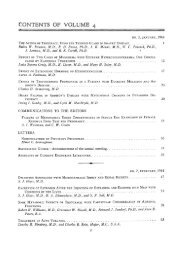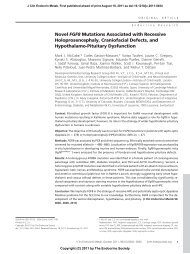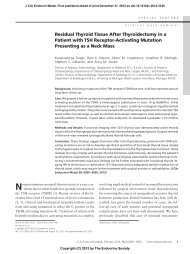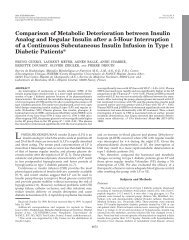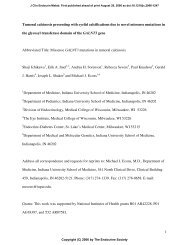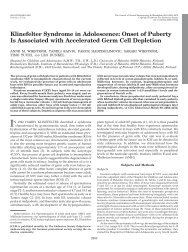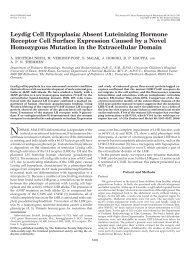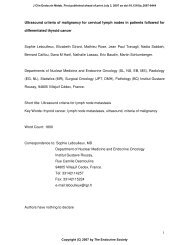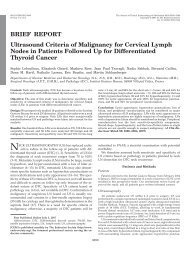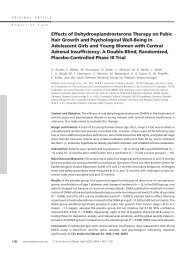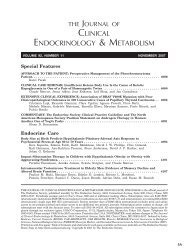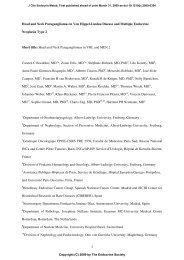The Effects Of Exercise-Induced Weight Loss On - The Journal of ...
The Effects Of Exercise-Induced Weight Loss On - The Journal of ...
The Effects Of Exercise-Induced Weight Loss On - The Journal of ...
Create successful ePaper yourself
Turn your PDF publications into a flip-book with our unique Google optimized e-Paper software.
J Clin Endocrinol Metab, April 2010, 95(4):1609–1616 jcem.endojournals.org 1611<br />
during the test (Polar type 610; Polar Electro Oy), and maximal<br />
heart rate was defined by adding five beats per minute to the<br />
highest heart rate value obtained during the VO 2max test.<br />
Body composition<br />
Body composition was measured using dual-energy x-ray absorptiometry<br />
(Hologic Discovery-A; Integrity Medical Systems<br />
Inc., Fort Myers, FL).<br />
Resting metabolic rate (RMR)<br />
RMR was measured by indirect calorimetry (Deltatrac II metabolic<br />
monitor; Datex-Ohmeda Division, Helsinki, Finland)<br />
with the participants fasted and laying supine for 30 min under<br />
a ventilated hood. Respiratory quotient was calculated as the<br />
ratio <strong>of</strong> carbon dioxide produced to oxygen consumed.<br />
Habitual food intake<br />
Participants were asked to maintain their normal diet<br />
throughout the study. This was verified by a 3-d estimated food<br />
diary (including at least one weekend day) using appropriate<br />
photographic booklets and household measures to improve the<br />
validity <strong>of</strong> portion size estimates, before the start <strong>of</strong> the study and<br />
at wk 12 <strong>of</strong> the exercise intervention.<br />
Blood sampling and subjective measures <strong>of</strong> appetite<br />
Participants visited the research unit in the fasted state (at least<br />
a 12-h fast), before and after the 12-wk exercise intervention (at<br />
least 48 h after the last exercise session to exclude acute effects <strong>of</strong><br />
exercise). <strong>On</strong> each occasion, an iv cannula was inserted into an<br />
antecubital vein. Two fasting baseline blood samples (�10 and 0<br />
min) were taken, and participants were asked to rate their baseline<br />
appetite using visual analog scales (VAS). Participants were then<br />
instructed to consume a standard breakfast [time (t) � zero] (consisting<br />
<strong>of</strong> bread, orange juice, milk, cheese, and jam: 600 kcal, 17%<br />
protein,35%fat,48%carbohydrate)within10min.Bloodsamples<br />
were taken at regular intervals for a period <strong>of</strong> 3 h (every 15 min in<br />
the first hour and every half hour in the second and third hours), and<br />
subjective appetite was assessed throughout the morning using<br />
VAS. Subjective feelings <strong>of</strong> hunger (“how hungry do you feel?”),<br />
fullness (“how full do you feel?”), desire to eat (“how much would<br />
you like to eat?”) and prospective food consumption (“how much<br />
do you think you can eat?”) were assessed using 10-cm self-rated<br />
VAS, as previously described (14), before and after breakfast and at<br />
every half hour up to 3 h.<br />
Hormone measurement<br />
Venous blood was collected into potassium-oxalate tubes for<br />
analysis <strong>of</strong> glucose and potassium/EDTA-coated tubes containing<br />
500 KIU aprotinin (Pentapharm, Basel, Switzerland)/ml<br />
whole blood for the measurement <strong>of</strong> insulin and gut peptides.<br />
Samples were then centrifuged at 2000 � g for 10 min and<br />
plasma analyzed immediately (for glucose) or kept at �20 C for<br />
later analyses. For the measurement <strong>of</strong> AG, 50 �l <strong>of</strong>a1N hydrochloric<br />
acid solution and 10 �l <strong>of</strong> phenylmethylsulfonyl fluoride<br />
(Sigma, Schnelldorf, Germany) (10 mg/ml <strong>of</strong> isopropanol)<br />
were added to each milliliter <strong>of</strong> plasma immediately after centrifugation.<br />
All samples were batch-analyzed at the end <strong>of</strong> the<br />
study to reduce interassay variability.<br />
Glucose was measured using standard laboratory techniques.<br />
Insulin, TG, and AG were quantified using human-specific RIA<br />
kits (Linco Research, St. Charles, MO) and GLP-1 and PYY<br />
“in-house” RIA methods (15, 16). <strong>The</strong> sensitivity <strong>of</strong> the assays<br />
was 14 pmol/liter for insulin, 93 pg/ml for TG, 7.8 pg/ml for AG,<br />
1 pmol/liter for GLP-1, and 2 pmol/liter for PYY. All samples<br />
were assayed in duplicate, and baseline and end samples <strong>of</strong> the<br />
same individual were analyzed in the same batch. <strong>The</strong> intraassay<br />
coefficient <strong>of</strong> variation was less than 10% for insulin, TG, and<br />
AG and less than 5% for GLP-1 and PYY.<br />
Measurement <strong>of</strong> insulin sensitivity<br />
Fasting insulin sensitivity, as a percentage <strong>of</strong> a normal<br />
reference population, was calculated using the<br />
HOMA2 Calculator version 2.2 (University <strong>of</strong> Oxford,<br />
Oxford, UK) (17).<br />
Statistical analysis<br />
Statistical analysis was carried out using SPSS 15.0 (SPSS Inc.,<br />
Chicago, IL). All variables were checked regarding their normal<br />
distribution using the Shapiro-Wilk test. Statistical significance<br />
was assumed at P � 0.05, unless otherwise stated.<br />
Differences in fasting plasma levels <strong>of</strong> metabolites/hormones<br />
and subjective feelings <strong>of</strong> appetite between the two blood sampling<br />
mornings (before and after the exercise intervention) were<br />
assessed by paired sample t tests. <strong>The</strong> effect <strong>of</strong> time and exercise<br />
(pre- vs. postintervention) on postprandial levels <strong>of</strong> metabolites/<br />
hormones and subjective feelings <strong>of</strong> appetite were assessed by a<br />
repeated measures ANOVA. Amplitude <strong>of</strong> variation for appetite-related<br />
hormones was calculated as peak minus nadir. For<br />
TG and AG, nadir was defined as the single lowest value after<br />
breakfast and peak as the single highest value preceding breakfast<br />
(average fasting plasma level). For GLP-1 and PYY, nadir<br />
was average fasting plasma levels, and peak was the single highest<br />
value after breakfast.<br />
<strong>The</strong> area under the curve (AUC) for plasma levels <strong>of</strong> appetiterelated<br />
hormones and subjective feeling <strong>of</strong> appetite was calculated<br />
from before to 180 min after breakfast using the trapezoidal<br />
rule. <strong>The</strong> effect <strong>of</strong> the exercise intervention on the AUC <strong>of</strong> each<br />
subjective feeling <strong>of</strong> appetite was assessed used paired sample t<br />
tests. Pearson (or Spearman) correlations were used to test the<br />
relationship between changes in the plasma levels <strong>of</strong> the hormones<br />
measured, changes in subjective feelings <strong>of</strong> appetite, and<br />
weight loss.<br />
Results<br />
Seven women did not complete the exercise program for<br />
several reasons including pregnancy, injury, and time constraints.<br />
No significant differences in baseline BMI or fitness<br />
levels (VO 2max in ml/kg/min) were observed between<br />
completers and noncompleters. Results are presented for<br />
15 subjects (seven women and eight men) with a mean age<br />
<strong>of</strong> 36.9 � 8.3 yr.<br />
<strong>Exercise</strong> compliance<br />
Participants who completed the intervention exercised<br />
at least 80% <strong>of</strong> the expected sessions (average,<br />
89 � 5.9%).



